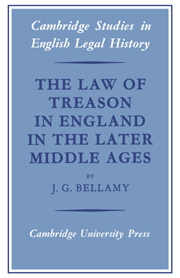Book contents
- Frontmatter
- Contents
- Editor's Preface
- Preface
- List of Abbreviations
- 1 The Medieval Concept of Treason
- 2 The Treatise Writers and the English Law of Treason at the End of the Thirteenth Century
- 3 The Origins of the English State Trial
- 4 The Great Statute of Treasons
- 5 The Scope of Treason, 1352–1485
- 6 Treason before the Courts, 1352–1485
- 7 The Origins and the Early History of the Act of Attainder
- 8 Treason and the Constitution
- Appendixes
- Select Bibliography
- Index
6 - Treason before the Courts, 1352–1485
Published online by Cambridge University Press: 14 October 2009
- Frontmatter
- Contents
- Editor's Preface
- Preface
- List of Abbreviations
- 1 The Medieval Concept of Treason
- 2 The Treatise Writers and the English Law of Treason at the End of the Thirteenth Century
- 3 The Origins of the English State Trial
- 4 The Great Statute of Treasons
- 5 The Scope of Treason, 1352–1485
- 6 Treason before the Courts, 1352–1485
- 7 The Origins and the Early History of the Act of Attainder
- 8 Treason and the Constitution
- Appendixes
- Select Bibliography
- Index
Summary
Under the common law at least the process of trial in cases of treason hardly differed in essence from that employed when the charge was felony or trespass. Treason had been clearly marked off from felony by the statute of 1352 but apart from allowing for the declaration of certain crimes in parliament no special procedures had been laid down. From the prisoner's viewpoint the only noticeable difference in being tried for treason was that he could not plead benefit of clergy and, if found guilty, he was dragged to the gallows behind a horse. Those accused of treason could not be tried under the peace commission but since justices of the peace regularly received commissions of oyer and terminer which remedied this deficiency there was little difference in this respect either. Because of the nature of the offence the king's officers seem to have worked with more than their usual application to ensure that charges were precise and that jurors were suitable and informed. This, no doubt, was one of the reasons why those who were tried for treason were usually found guilty whereas those accused of felony were in the majority of cases acquitted. In the fourteenth century trials for treason and felony, if they were not the result of an appeal by an individual, were begun by one or by several juries of the locality presenting the misdeeds of the accused. How far the choice of charge was left to the jurors and how far matters were decided in advance by the law officers of the crown is hard to determine.
- Type
- Chapter
- Information
- The Law of Treason in England in the Later Middle Ages , pp. 138 - 176Publisher: Cambridge University PressPrint publication year: 1970

